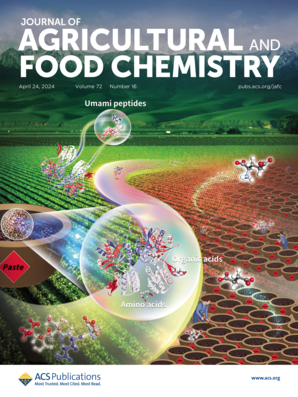Enantioselective Metabolism of Chiral Fungicide Prothioconazole by Mycobacterium sp. Y-3 and Its Bioaugmentation
IF 5.7
1区 农林科学
Q1 AGRICULTURE, MULTIDISCIPLINARY
引用次数: 0
Abstract
Prothioconazole (PTC) is a kind of chiral triazole fungicide widely used in agricultural production, which can easily cause residual contamination and chiral selective toxicity. Microorganisms are the main participants involved in pollutant degradation in the environment. However, studies on the microbial enantioselective degradation of PTC and bioaugmentation of PTC-contaminated soil are still scarce. Herein, we isolated an efficient PTC-degrading strain, Mycobacterium sp. Y-3. Strain Y-3 preferentially metabolized (R)-PTC over (S)-PTC; the degradation rate of (R)-PTC was 2.5 times that of (S)-PTC. The T1/2 values of 20–80 μM (Rac)-/(S)-/(R)-PTC after treatment with strain Y-3 were 4.1–7.1 h at 37 °C and pH 5.0. The addition of glutamine could significantly enhance the PTC degradation ability of strain Y-3. Strain Y-3 metabolized PTC via methylation to form prothioconazole-S-methyl, the detoxification pathway for PTC. In bioaugmentation experiments, strain Y-3 eliminated PTC residues in the soil within 12 days. High-throughput sequencing analysis indicated that strain Y-3 colonized well in the soil. Inoculation with strain Y-3 reduced soil microbial community diversity and richness, while the bioaugmentation treatment enhanced the soil microbial community associations. These findings provide new insights into the enantioselective microbial metabolism of chiral PTC and in situ bioaugmentation of PTC-contaminated soils.

手性杀菌剂Prothioconazole在分枝杆菌Y-3的对映选择性代谢及其生物增强作用
原硫康唑(Prothioconazole, PTC)是一种广泛应用于农业生产的手性三唑类杀菌剂,易造成残留污染和手性选择性毒性。微生物是环境中污染物降解的主要参与者。然而,微生物对PTC的对映选择性降解和PTC污染土壤的生物强化研究仍然很少。本研究分离出一株高效降解ptc的分枝杆菌Y-3。菌株Y-3优先代谢(R)-PTC而不是(S)-PTC;(R)-PTC的降解速率是(S)-PTC的2.5倍。菌株Y-3在37℃、pH 5.0条件下处理后,20 ~ 80 μM (Rac)-/(S)-/(R)- ptc的T1/2值为4.1 ~ 7.1 h。谷氨酰胺的添加可显著提高菌株Y-3对PTC的降解能力。菌株Y-3通过甲基化代谢PTC,形成原硫代康唑- s -甲基,这是PTC的解毒途径。在生物增强实验中,菌株Y-3在12天内消除了土壤中的PTC残留。高通量测序分析表明,菌株Y-3在土壤中定植良好。接种菌株Y-3降低了土壤微生物群落的多样性和丰富度,而生物增强处理提高了土壤微生物群落的关联性。这些发现为手性PTC的对映选择性微生物代谢和PTC污染土壤的原位生物增强提供了新的见解。
本文章由计算机程序翻译,如有差异,请以英文原文为准。
求助全文
约1分钟内获得全文
求助全文
来源期刊
CiteScore
9.90
自引率
8.20%
发文量
1375
审稿时长
2.3 months
期刊介绍:
The Journal of Agricultural and Food Chemistry publishes high-quality, cutting edge original research representing complete studies and research advances dealing with the chemistry and biochemistry of agriculture and food. The Journal also encourages papers with chemistry and/or biochemistry as a major component combined with biological/sensory/nutritional/toxicological evaluation related to agriculture and/or food.

 求助内容:
求助内容: 应助结果提醒方式:
应助结果提醒方式:


